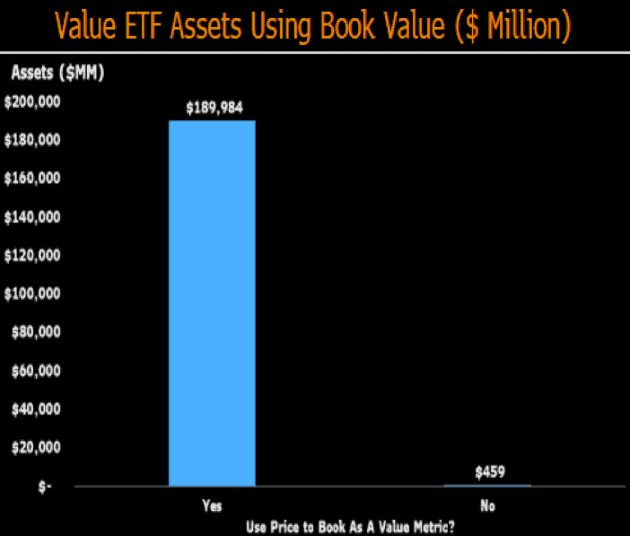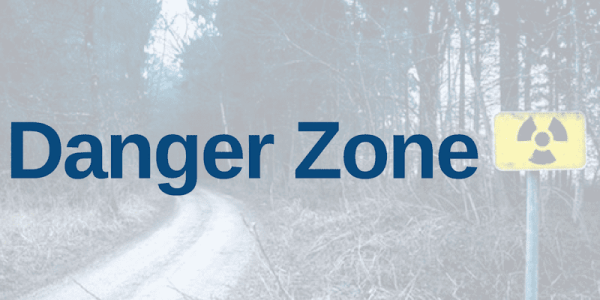Check out this week’s Danger Zone interview with Chuck Jaffe of Money Life.
“The fact is that the annual change in Berkshire’s book value… is a metric that has lost the relevance it once had.”
-Warren Buffett in his 2018 letter to Berkshire Hathaway shareholders
“I was wrong in a couple of ways about Kraft Heinz. We overpaid for Kraft.”
-Buffett on CNBC, two days later
The two quotes above might serve as the epitaph on the grave of the old era of value investing. First off, Buffett – who has opened every letter to shareholders for almost 30 years by noting the change in Berkshire’s book value – explains why book value has lost its relevance to investors. Second, he admits that he got the investment thesis wrong on Kraft Heinz (KHC) after the company wrote-down $15 billion (~14% of its book value) in goodwill, which caused the stock to plummet nearly 30%.
The common thread here is the limitations of accounting book value. Accounting rules lead to Berkshire’s numerous operating companies appearing undervalued on the balance sheet. The same rules led KHC’s balance sheet to significantly overstate its value. Unfortunately, much of what passes for value investing today, whether it’s mutual funds, individual investors, or index funds, relies on accounting book value and other metrics whose utility has atrophied significantly over the years. These “traditional value” investors, and especially investors in the iShares S&P Small-Cap 600 Value ETF (IJS) are in the Danger Zone.
99.8% of “Value” ETFs Rely on Book Value
When people talk about “value” today, most of the time what they’re actually talking about is price-to-book. The numbers that show value stocks have underperformed growth are based the underperformance of the Russell 1000 Value ETF (IWD), which selects stocks primarily on the basis of low P/B. Indeed, as Figure 1 shows, 99.8% of the assets allocated to value ETFs go to funds that use P/B in their methodology.
Figure 1: Value ETFs that Use P/B vs. Those That Don’t

Sources: @EricBalchunas
With this reliance on P/B, it’s no surprise that 18 different value ETFs have exposure to KHC. Prior to its crash, KHC had a P/B of just 0.9. Investors that relied solely on this ratio may have thought that KHC was trading at a discount to its fair value. However, our research into the company’s cash flows showed that KHC had been significantly overvalued for a long time.
As Warren Buffett noted above, he was wrong on Kraft. He overestimated the value of the company’s brands and distribution networks and underestimated the significance of changing consumer tastes. On the other hand, the investors that sunk millions of dollars into KHC via value funds weren’t wrong about KHC, they likely never had an opinion in the first place.
A Value ETF Investors Should Avoid
The iShares S&P Small-Cap 600 Value ETF (IJS) is one of our least favorite value ETFs and earns our Unattractive rating. As Figure 2 shows, despite promising to give investors value, IJS actually holds more overvalued stocks than a small cap blend ETF such as the Vanguard Small-Cap Index Fund (VB).
Figure 2: IJS Asset Allocation Compared to VB

Sources: New Constructs, LLC and company filings.
IJS allocated 47% of its assets to Unattractive-or-worse stocks compared to 44% for VB, and it allocates 10% to Attractive-or-better compared to 11% for VB.
When we look at valuation metrics for the entire portfolio, IJS also compares poorly to VB. Its holdings have a weighted-average price to economic book value (PEBV) ratio of 3.5 compared to 3.3 for VB. Far from holding value stocks, IJS actually holds stocks that are more expensive than the average small cap stock.
Facilities manager ABM Industries (ABM) is one of our worst-rated stocks held by IJS. ABM looks cheap by traditional value metrics with a P/B of 1.6, but our research shows otherwise.
The biggest red flag for ABM comes from the fact that it has $1.8 billion in goodwill on its balance sheet compared to just $1.5 billion in accounting book value. If you strip out this intangible asset that can be written down at any point, ABM actually has a negative book value.
Our models suggest that ABM is at high risk for a write-down in the near future. The company has made several large acquisitions in recent years, most notably the $1.3 billion acquisition of GCA Services Group in 2017. However, its return on invested capital (ROIC) has remained stagnant at 5% for each of the past three years while its weighted average cost of capital (WACC) is 6%. Investing capital that earns a return below your cost of capital destroys value for shareholders.
When you look past P/B and analyze the cash flow expectations embedded in the stock price, one can see how expensive ABM truly is. In order to justify its valuation of $36/share, ABM must grow after-tax operating profit (NOPAT) by 5% compounded annually for 14 years. See the math behind this dynamic DCF scenario.
Investors in IJS are allocating ~$400 million to ABM due solely to the fact that the company has inflated its balance sheet and earnings through overpriced acquisitions. If investors do more diligence and thoroughly analyze the company’s cash flows and valuation, they can understand why ABM is not truly a value stock. We wish more investors did their diligence.
“Value” Is Just A Factor, Not a Strategy
Very few investors these days can truly be classified as “value” investors. Value investing, in theory, is a comprehensive strategy that involves thoroughly analyzing assets and cash flows to identify companies that are trading below their fair value. In practice, almost no one does that work. Instead, “value” investors shortcut the process with overly simplistic and easy-to-use metrics like P/B, ROE, P/E, EV/EBITDA etc. In the end, “value” funds today provide investors little more than exposure to a factor or set of factors. The investment merit of these factors either never existed, or they have been exhausted due to changes in accounting rules or overcrowding of popular trading strategies. Importantly, the diligence that many investors assume is being done to understand the companies in which they’re investing is not happening.
For many other investors, value is merely a component of their portfolio, a bucket to fill, rather than an overall strategy for selecting stocks. This way of thinking leads investors to abdicate their responsibility to perform the diligence upon which the value investing philosophy was built. As long as investors have exposure to the “value“ factor, they don’t feel they need to know the details of that exposure.
Many supposedly active value managers do not even try to be true value investors. Research shows that the majority of active managers are “closet indexers” that hold broadly similar stocks (and earn similar returns before fees) to index funds. Many active investors are reluctant to diverge significantly from their benchmarks for fear that they’ll underperform and lose assets.
For those “value” managers that do stray from their benchmark, the end result is often to chase momentum rather than identify true value. Think of Bill Miller, the famous value investor who broke the mold and bought Amazon (AMZN), AOL, and Yahoo during the tech bubble. Buying these stocks helped him to a 15-year streak of outperformance, but his willingness to chase momentum also led to a long period of poor returns around the ’08 crash.
It’s hard to blame all these investors for moving to simpler factors and strategies. After all, value investing is hard. Even Warren Buffett can get it badly wrong from time to time, as his experience with KHC shows. Still, we believe with the right work ethic and technology, value investors can outperform and help make capital markets more efficient.
Value Investing 2.0
People that declare value investing dead because companies with low P/B’s have underperformed over the past decade are confusing the means with the end. Price-to-book is just one way that investors have attempted to execute value strategies. The metric worked for a time, but as companies and accounting rules became more complicated, it lost its utility. The same can be said for price to earnings, ROE, EV/EBITDA and every other popular metric, i.e. short cut.
The answer for diligent value investors is not to give up entirely. Instead, we must work a little harder, do more diligence, dig deeper into financial filings, go beyond the income statement and balance sheet into the financial footnotes to reverse accounting distortions, and measure the true cash flows of a business. As we’ve written before, value investing isn’t dead, but it has gotten harder.
Fortunately, as value investing has become more challenging, new tools have risen to meet the challenge. Robo-Analyst technology[1] can read 200+ page 10-K reports in seconds, automatically collecting hundreds of data points and flagging notable items in the footnotes for humans to interpret. This technology allowed us to analyze 175 annual 10-K reports in a single day last week.
This diligence empowers investors to identify companies that look expensive based on traditional value metrics but are cheap when we analyze their true cash flows and vice versa.
A Value Stock that Traditional Metrics Miss
Oracle Corporation (ORCL) would not pass most traditional value screens. It has a P/B of 6.2 (above the S&P 500 average of 3.3), and a P/E of 53 (above the S&P 500 average of 22).
However, these simple metrics don’t tell the full story. Oracle’s reported earnings are understated due to a $7 billion (18% of revenue) charge from tax reform. The company’s trailing twelve months (TTM) GAAP net income is just $4 billion, but its NOPAT is $11.3 billion.
Meanwhile, Oracle’s book value does not account for many of the intangible assets – technological expertise, customer relationships, brand value, etc. – that are so crucial for any big tech company. Many tech companies rely heavily on intangible assets that the balance sheet doesn’t capture, which is why value indexes systematically underweight tech. Since tech is one of only two sectors with rising economic earnings, it’s no surprise that traditional value indexes underperform.
At Oracle’s current valuation of ~$52/share, the stock has a PEBV of 1.2. This ratio implies that the market expects Oracle to grow NOPAT by no more than 20% for the remainder of its corporate life. For a company that has grown NOPAT by 7% compounded annually for the past decade, that’s a pessimistic expectation.
Even if Oracle grows NOPAT at a slower rate of 5% compounded annually for the next decade, the stock is worth $63/share today, a 21% upside from the current price. See the math behind this discounted DCF scenario.
Traditional value investors might ignore ORCL, but our analysis shows the stock is undervalued.
This article originally published on March 4, 2019.
Disclosure: David Trainer, Sam McBride and Kyle Guske II receive no compensation to write about any specific stock, sector, style, or theme.
Follow us on Twitter, Facebook, LinkedIn, and StockTwits for real-time alerts on all our research.
[1] Harvard Business School features the powerful impact of our research automation technology in the case study New Constructs: Disrupting Fundamentals Analysis with Robo-Analysts.
